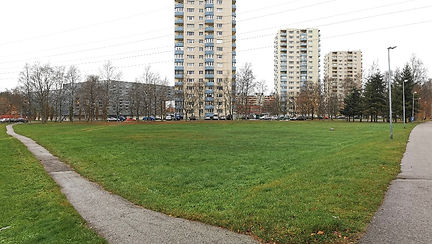Species-Richness in the City
People have a natural need to spend time in the greenery. Lively green spaces in cities improve our well-being and keep our spirits alert. It is increasingly important to think about ways how the built environment and natural environment can be integrated in cities as more and more of us live in cities on a daily basis.
Replacing the overhead power lines with an underground cable will free up a 50-metre-wide area to create a new linear park on the Pollinator Highway. When planning a park, it is important to preserve and increase biodiversity. In 2019 pollinator surveys were carried out on the northern section and midsection of the Pollinator Highway. The surveys confirmed that long sections of the Pollinator Highway are already rich in biodiversity, best characterised by diverse vegetation and pollinators: butterflies, bumblebees and solitary bees. 20 species of bumblebees, 23 species of solitary bees and 32 species of butterflies were counted on the Pollinator Highway. 10 species of protected bumblebee are present in the area. But the Pollinator Highway runs through the habitats of several other protected species: reptiles and amphibians (8 species), bats (10 species) and vascular plants (18 species).
Urban Meadow Pilot Sites
If the meadow vegetation is allowed to grow tall, oases of biodiversity will form. Extensive low-cut lawns are a beauty ideal of the past. Mowing less often is beautiful and useful: by doing so, we create habitats for both ordinary and rare species, we give expression to the area. In summer we can enjoy a variety of flowers, listen to birds singing and insects buzzing. Uncut green areas do not become unsightly in summer heat, they also require less maintenance. A green area with overgrown meadow vegetation absorbs more rainwater than an immaculately mowed lawn, reducing the load on sewers, being an example of how balanced urban nature can benefit nature, people and urban systems at the same time.
During the Pollinator Highway B.Green project we will be testing various methods of creating species-rich meadows in the city. We aim to find a balance between benefiting urban nature and providing people with an enjoyable environment.
If you have ideas or suggestions how a species-rich city should look like; also if you wish to participate in cultivating urban meadows, please contact us!

Our vision of a species-rich urban meadov in 105c Ehitajate road

Urban Meadow pilot site in 105c Ehitajate road today
Väike-Õismäe Flower Meadow
The flower meadow of Putukaväila is located in Väike-Õismäe, on the real estate of Ehitajate tee 105c. We sowed the seeds of focus plants in yellow tones and the seeds of flowering plants in cold tones beyond the walkway by the walkways passing through the property. The focus plants of the flower meadow are divided into three groups according to colors and species. These are the combinations of the field blueberry-bell in the cold blue-white tones and the ryegrass-beech and the golden-bell-globe in the warm tones. The seeds of background plants have been collected from the meadow of Pärnu County as a mixed seed consisting of 20 plant species. Thus, all the designed areas consist of the same background plants, but the focus is on different prominent blooms at different times of the summer.
For example, in a combination of cool-toned field terns, a common tortoise with a dark blue flower begins to bloom in mid-June; In addition, they are accompanied by smaller flowers throughout the meadow. The appearance of the flower meadow changes during the summer and new accent plants and patterns become more and more attractive.
In autumn, the meadow is mowed, hay is picked up and removed. Removing hay is important so that next year the smaller plant species will have more light and space to grow again. Under the backward layer, they would disappear in the dark and lack space to grow, leaving fewer plant species in the area and less biodiversity.







